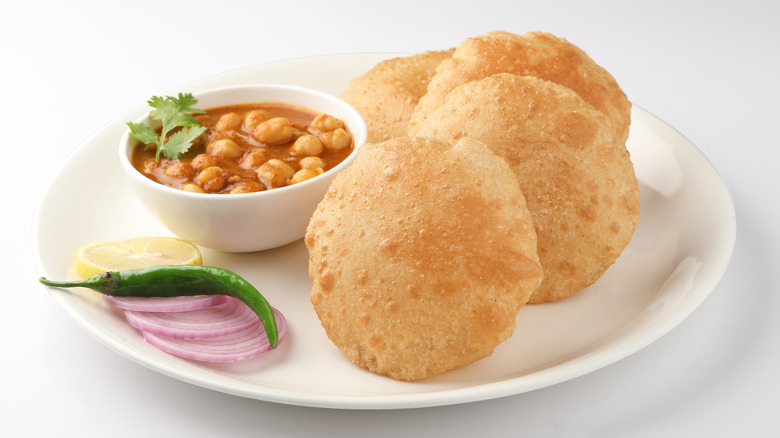Bhatura: The Deep Fried Indian Bread You Should Know About
Indian cuisine is well known for its curries, choles, and masalas, and you may have a few favorites, but their large variety of leavened and unleavened breads are also world-renowned. These breads have a long history in the country, and the earliest traces go back over 5,000 years. According to The Space, wheat cultivation in the country dates back to 3000 B.C. Certain excavations in the Northwest region have revealed fragments of flat baking pans used to make roti, an umbrella term for unleavened flatbreads.
Similarly, evidence of consumption of this type of bread can be found in ancient Vedic texts. The Space notes its mention of Purodhashas, "a stuffed thick pancake which was offered to deities during the rituals."
Centuries later, in 1857, a bizarre claim gripped British traders, per BBC. They became paranoid that Indians were transporting secret messages through chapatis, thin unleavened flatbreads. And this event, in some ways, began the entire dismantling of the British East India Company. Bread, undoubtedly, has played an important role in Indian history, including bhatura. Also spelled bhatoora, this famous deep-fried leavened bread is delightful on its own or as one half of the beloved chole bhature dish.
History of bhatura
Bhatura is a traditional fried bread that originated in the Punjabi region, per 196 Flavors. Punjab is an Indian state that borders Pakistan and has had many historic invaders and travelers that have influenced its culture (via Britannica). The bread is especially popular across the Northern Indian peninsula and in the west of Pakistan. The original bread recipe included white flour, yogurt, and clarified butter (ghee).
While some Indian flatbreads, like naan, are made in a tandoor oven, bhatura is deep-fried and typically stuffed with different foods, like paneer. And, it is hard to talk about bhatura without mentioning chole bhature, where the fried bread is paired with a spiced chickpea curry named chana masala, according to A Global History of Food. As Taste Atlas notes, this dish can be found throughout North India, but was created in Delhi in the 1940s. It is most typically eaten for breakfast because it can sustain you all day long.
Ingredients in bhatura
India has a variety of both leavened and unleavened breads, but bhatura is a leavened bread, which means it incorporates a rising agent. According to Tarladalal.com, yeast can be used, but it doesn't have to be. Cook with Manali's recipe, for example, incorporates baking powder and baking soda as leavening agents. The rest of the dough is typically made from all-purpose flour, semolina, sugar, salt, yogurt, milk, and oil. The dough incorporates two different types of flour because according to Bob's Red Mill, semolina can help bread have a crispy crust and create desirable textures.
Once the dough is made, it is rolled out into a thin disc and fried in hot oil, per 196 Flavors. When it hits the oil, it puffs up like a balloon, which makes it a perfect vehicle for stuffing with other ingredients. This delicious crispy bread is a perfect snack solo or paired with curry for a satisfying meal.
How to eat it
There is nothing quite like the taste of fresh bhatura. Indian Healthy Recipes describes it as magical, noting that the dough has a fermented flavor like sourdough.
As mentioned previously, chole bhature is likely the most popular way to consume the bread. The chole (chickpea curry) has a spicy and tangy flavor and it is served warm. One of the most common beverages to wash it down with is lassi. Lassi is a creamy yogurt drink that is served chilled in India, and it is described as greatly refreshing (via Simply Recipes). Other popular items to pair with chole bhature are onions, pickles, and mint chutney, according to Taste Atlas.
Chole bhature can be found as a street food all across North India, but it is also often prepared in people's homes. It can be eaten any time of day, but when it is eaten for breakfast, the bhature are likely filled with potatoes or cottage cheese. This hearty breakfast is very filling, making it a great meal to start the day. This iconic duo, as Cook with Manali puts it, "are meant for each other!"
Other types of flatbreads
As we mentioned previously, bhatura separates itself from other Indian flatbreads because it is leavened and deep-fried, as opposed to baked or pan-fried. While this deep-fried flatbread is clearly worth trying, there are so many other varieties to explore.
For instance, have you heard of chapati? According to the Michelin Guide, chapati comes from the word "slap" in Hindi. The slap refers to the process in which it's made. In order to form it into the proper shape, it is slapped between one's palms before it hits the tava (circular, flat frying pan). While this is an everyday bread, kulcha is more decadent. This soft and chewy bread is made on a griddle and can come stuffed with potatoes and vegetables in the Amritsari kulcha dish, per Times of India.
And then there's pesara dosa. This ultra-thin pancake is a popular breakfast food in the country, and is India's national dish, according to Taste Atlas. The site notes that dosa is the thinnest griddlecake in the world and has an earthy flavor from its fermentation process. The final result is a bubbly yet thin pancake with a buttery flavor.
These breads, however, are just a few examples of the dozens of varieties available in India. If you want to start trying out some famous Indian flatbreads for yourself, it doesn't matter how you begin, just start eating.




